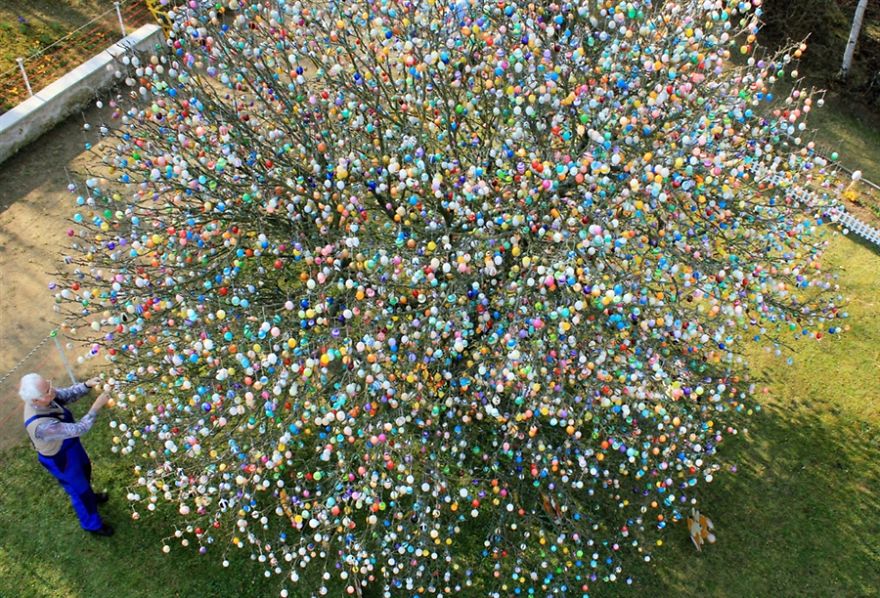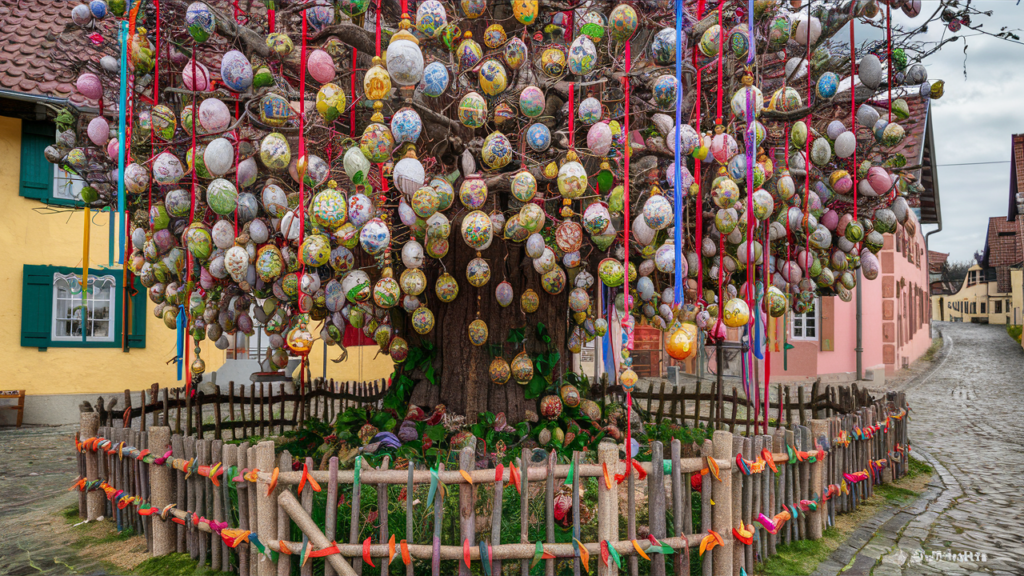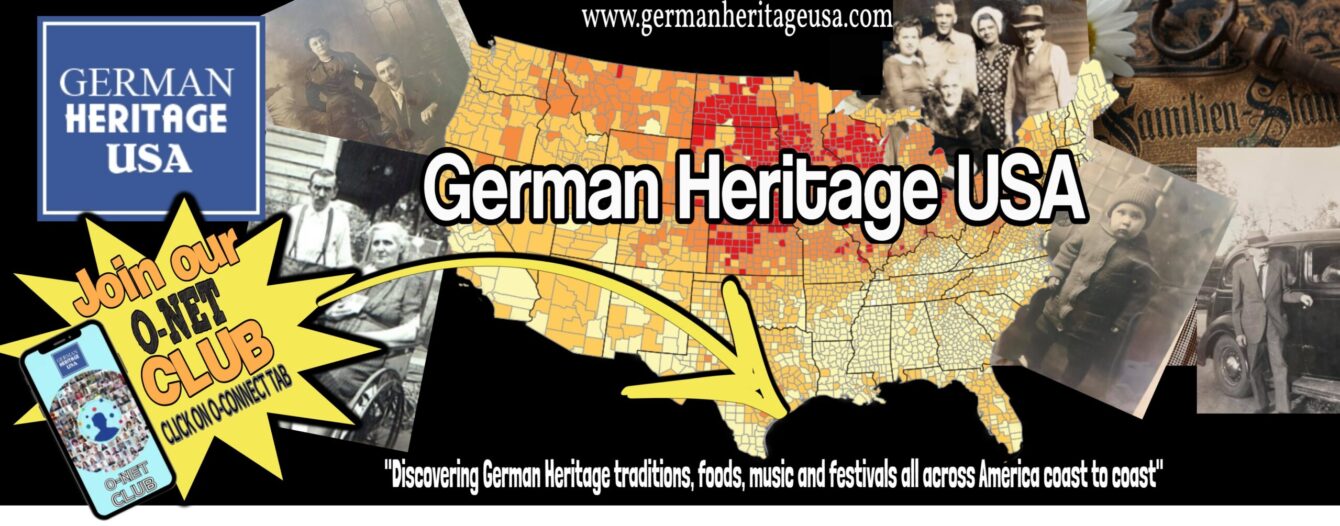A Spectacular Speckled Spectacle: The Story of the 10,000 Egg Tree and the Tradition of German Easter Trees
GERMAN HERITAGE USA | AFFILIATE DISCLAIMER: This post may or may not contain affiliate links which means we may receive a commission for purchases made through links. We will only recommend products that we have personally used or that we truly trust. Learn more on our Private Policy and Disclaimer Page located under our Terms Of Service tab above.
A family in Germany has a tradition of decorating a tree outside their home with 10,000 Easter eggs! It takes them about two weeks to complete this amazing feat.

Their tradition began in 1965 and has continued ever since. These colorful decorated trees, called Eierbaum, Osterbaum or Ostereierbäume in German, are a common sight in Germany during Easter.
See the original 10,000 easter egg tree decoration article by clicking here
Spring is a time of renewal, and for many cultures, Easter marks a joyous celebration of new beginnings. In Germany, the tradition of decorating trees with eggs takes this celebration to a whole new level. This article dives into the fascinating story of the 10,000 Egg Tree in Saalfeld, Germany, explores the history and variations of German Easter trees (Ostereierbäume), and provides tips for creating your own dazzling display and appreciating the art of intricately decorated eggs.
The Legendary 10,000 Egg Tree: A Feat of Dedication and Dazzling Display
Nestled in the heart of eastern Germany lies the town of Saalfeld, forever linked to a remarkable Easter tradition. For over 50 years, the Kraft family, led by Volker Kraft, meticulously adorned an apple tree in their garden with hand-painted Easter eggs. This wasn’t your average Easter basket decoration. By 2012, the tree boasted a staggering 10,000 eggs, a testament to the family’s dedication and the sheer joy of the tradition.
Sadly, due to storage limitations and the sheer volume of eggs, the Kraft family decided to stop adding to the tree in 2015. However, the legend of the 10,000 Egg Tree lives on, a reminder of the transformative power of Easter decorations and the enduring spirit of German traditions.
Beyond Saalfeld: Unveiling the History of German Easter Trees
The tradition of decorating trees with eggs in Germany, known as Ostereierbaum or Osterbaum, stretches back centuries. The exact origins remain unclear, but some historians believe it stems from pagan fertility rituals that were later incorporated into Christian Easter celebrations. Eggs, symbolizing new life and rebirth, became a natural choice for adorning trees during this springtime holiday.

Over time, the tradition evolved. Initially, real eggs were used, but as the practice gained popularity, hand-painted wooden eggs became more common. Today, Ostereierbäume come in all shapes and sizes, adorned with a dazzling array of colorful eggs, ribbons, and other decorations.
A Tradition Takes Root: Where to Find Easter Egg Trees in America
While the 10,000 Egg Tree might be a unique German phenomenon, the tradition of Easter egg trees has found a welcoming home in the United States. Here are some places where you can experience the charm of Ostereierbäume in America:
- German-American Cultural Centers: Many cities with significant German-American populations host Easter celebrations that include decorated Easter trees. These events offer a chance to experience German traditions firsthand, often with traditional music, food, and activities.
- Museums with German Collections: Some museums with collections of German folk art or Easter decorations might showcase traditional Ostereierbäume or intricately decorated eggs during the Easter season.
- German Restaurants and Bakeries: Some German restaurants and bakeries might decorate their establishments with Easter egg trees, adding a festive touch to their Easter celebrations.
Creating Your Own Ostereierbaum: A Guide to a Speckled Spectacle
Inspired by the beauty of German Easter trees? You can create your own dazzling display! Here’s a basic guide:
- Choosing Your Tree: Select a sturdy branch or small tree that can accommodate your decorations. If using a branch, secure it in a sturdy vase or pot filled with gravel or floral foam.
- Egg-cellent Decorations: Gather your eggs! You can use real or fake eggs, depending on your preference. For a classic touch, hand-paint your eggs with vibrant colors and designs. Alternatively, you can decorate pre-colored eggs with glitter, stickers, or ribbons.
- Branching Out with Creativity: Don’t limit yourself to eggs! Consider adding ribbons, flowers, feathers, or other Easter-themed ornaments to your tree for an extra touch of charm.
- Display with Pride: Find a prominent spot in your home to showcase your Ostereierbaum. The vibrant display will add a festive touch to your Easter celebrations.
A World of Eggsquisite Delights: Exploring German Egg Decorating Traditions
German egg decorating is an art form in itself. Beyond the colorful painted eggs used on Ostereierbäume, intricate techniques like kratzeier (scratch-decorating) and spitzbogen (using beeswax to create resist patterns) are passed down through generations.

Where to See Exquisite Egg Decorations in the USA
While experiencing the full spectrum of German egg decorating traditions might require a trip to Germany, here are some ways to appreciate these exquisite crafts in the US:
- German Christmas Markets: Many German Christmas markets held in major cities across the US often feature stalls selling traditional German Easter decorations, including intricately decorated eggs. These markets offer a chance to admire the craftsmanship and purchase unique keepsakes.
- Museum Collections: Museums with decorative art collections might have exhibits showcasing traditional Easter eggs from Germany. These exhibits can provide insights into the techniques, symbolism, and regional variations in German egg decorating traditions.
- Online Marketplaces: The internet offers a window to the world of German egg decorating. Explore online marketplaces like Etsy to find artisans selling traditional or contemporary takes on German Easter egg designs.
A Celebration of Spring and Creativity
The German Easter tree tradition, with its dazzling displays and intricate egg decorations, is a vibrant celebration of spring and creativity.

From the legendary 10,000 Egg Tree to the enduring presence of Ostereierbäume in homes and communities, this tradition serves as a reminder of the beauty and joy found in simple things.
So, this Easter, consider creating your own Ostereierbaum, appreciate the artistry of German egg decorating, and embrace the spirit of renewal that this colorful tradition embodies.
